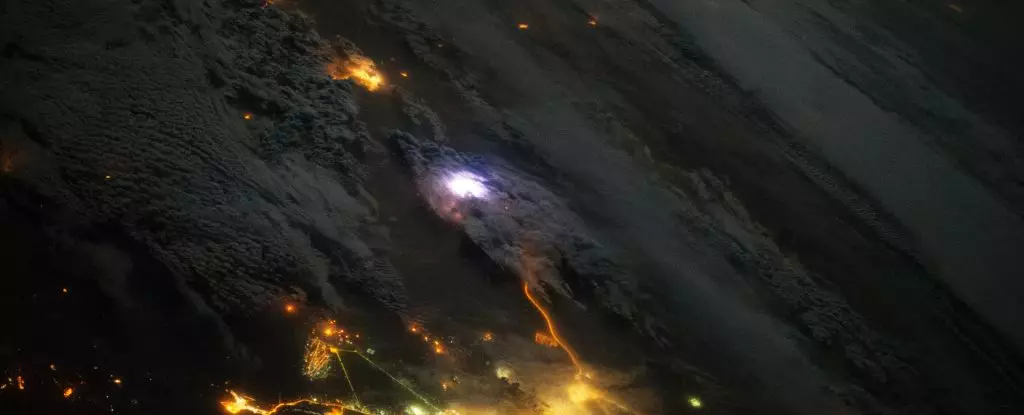Lightning storms present one of nature’s most awe-inspiring spectacles, illuminating the sky with electric brilliance. However, recent scientific discoveries reveal that the consequences of these storms extend far beyond terrestrial disturbances. New research uncovers a fascinating relationship between powerful lightning events and the formation of high-energy “killer” electrons within Earth’s radiation belts—an unsettling phenomenon that has implications for both our planet and activities beyond its atmosphere.
Lightning’s Cosmic Influence
Historically, researchers have regarded the Van Allen radiation belts—two layers of charged particles encircling Earth, created by its magnetic field—as relatively stable entities. They play a crucial protective role, shielding our planet from solar radiation and cosmic threats. However, recent findings challenge this perception by linking lightning strikes to the release of these elusive and dangerous killer electrons. These particles, traveling at speeds approaching that of light, possess the energy to penetrate satellite shielding and wreak havoc on sensitive electronic equipment, raising concerns for both astronauts and technological infrastructure.
Upon further examination of satellite data, aerospace engineer Max Feinland and his team observed an unexpected uptick in the levels of high-energy electrons coinciding with lightning events. This correlation primarily stems from whistler waves—low-frequency electromagnetic waves generated during lightning discharges—which appear to facilitate the transfer of energy among particles in the radiation belt. This detailed mechanism may hold the key to understanding how our most formidable storms inspire activity not only in our atmosphere but also in the vastness of space.
The Chain Reaction of Energy Transfer
The process through which lightning generates killer electrons reveals complex interactions between electromagnetic phenomena and plasma physics. The whistler waves create conditions within the radiation belt that allow lower-energy electrons to accelerate and elevate to high-energy states. This sequence of events suggests a chain reaction, where energy cascades from one electron to another—a dynamic that could provide insight into broader mechanisms governing particle acceleration across the universe.
Feinland’s research uncovered a remarkable pattern: during a decade spanning from 1996 to 2006, there were 45 distinct instances of high-energy electron surges within the inner radiation belt. Further analysis indicates that many of these spikes occurred mere moments after lightning strikes were detected on the surface. This emerging correlation is an exciting development in our understanding of the interconnectedness between atmospheric weather and space weather—a phenomenon that historically remained unexamined.
The implications of these findings stretch far beyond academia; they bear significant consequences for human space exploration. Killer electrons, for all their scientific intrigue, pose genuine health risks to astronauts navigating low-Earth orbit, where exposure to such radiation can lead to increased cancer risks. In addition to this grave concern, the potential for equipment failures in satellites and spacecraft remains an ongoing threat exacerbated by lightning-induced electron surges.
Essentially, this new knowledge underscores the critical need for stricter safety measures during missions conducted in storm-prone regions. As collaboration between climate scientists and space physicists increases, we may be able to develop more effective forecasting models that take into account not just terrestrial weather but the significant interplay of cosmic events influenced by these storms.
The recognition of lightning events affecting particle dynamics in the Van Allen belts prompts further inquiries into the specific conditions necessary for these interactions. Environmental factors such as solar activity, plasma density, and wave behavior are pivotal in influencing how frequently these killer electrons will surge into existence.
Continued investigations and advanced technological monitoring systems will be essential in isolating and understanding these dynamics more comprehensively. The insights gleaned from this research will likely not only aid in protecting astronauts and satellites but also advance our overall understanding of plasma behavior in different celestial environments.
What began as an appreciation for the grandeur of storms now develops into an intricate exploration of the interplay between lightning and high-energy phenomena in space. As we unravel the tapestry of connections between Earth’s atmospheric events and the cosmic domain, it becomes clear that our world—while sheltered and vast—remains intricately linked to the cosmos. As researchers continue to delve into these exciting revelations, the implications may shift not only our understanding of physics but also the practical safety measures necessary for future exploration of the outer reaches of our solar system. For now, astronauts may want to heed the old adage: when it storms outside, keep a low profile—both on Earth and in orbit.


Leave a Reply